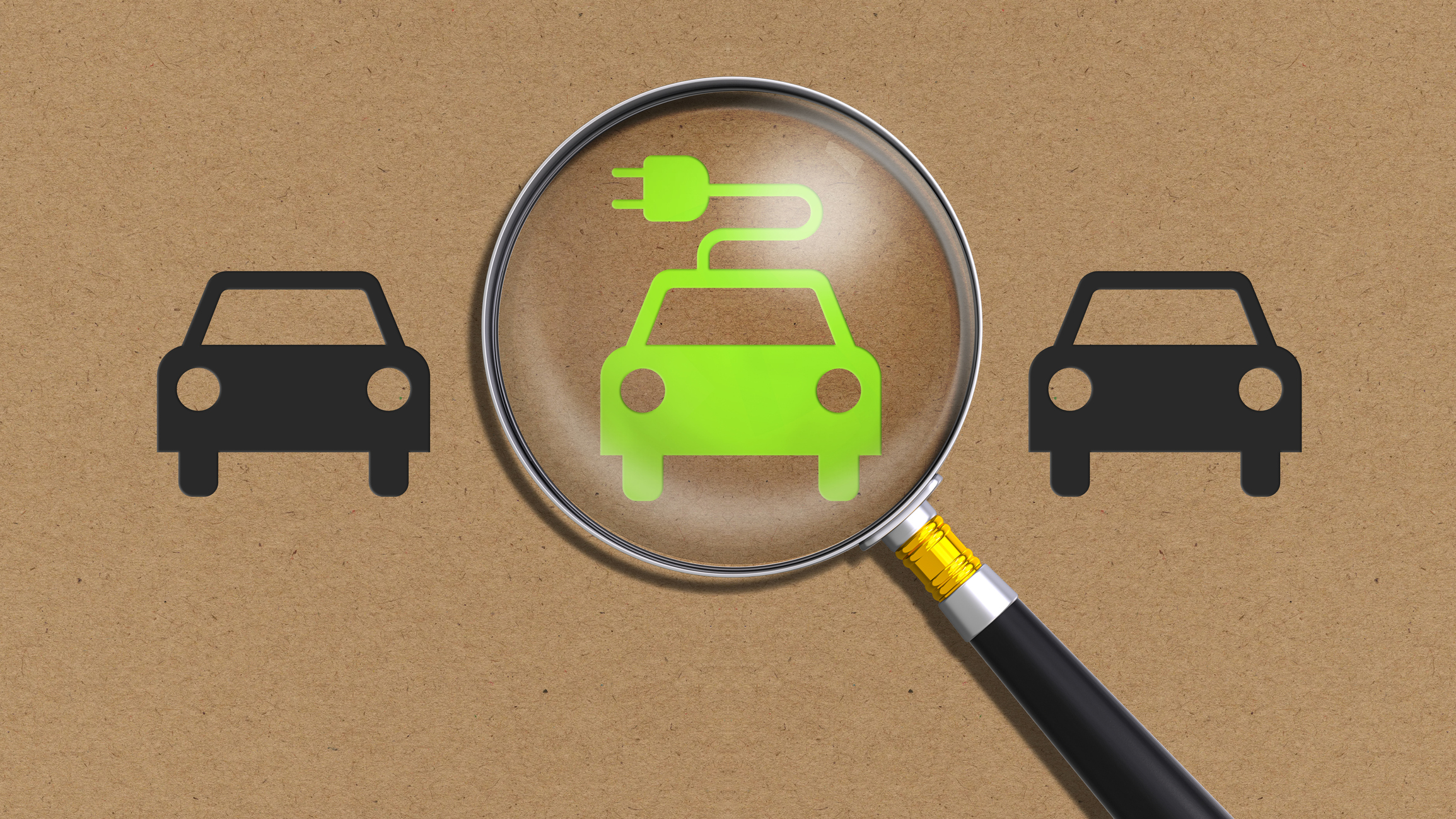How the EV Tax Credit Works
The $7,500 EV federal tax credit can be complicated for buyers and manufacturers. Here's what you should know.


A federal tax credit for electric vehicles (EVs) is here thanks to the Inflation Reduction Act (IRA), massive legislation promoting clean energy. The credit of up to $7,500 for qualifying EVs, called "clean vehicles," is supposed to encourage EV adoption.
However, this tax break, which is also available for some used electric vehicles, is complicated, so there are many questions about how the EV tax credit works.
Key points
- Income limits apply, affecting eligibility for some buyers. (More on that later.)
- Treasury and IRS have released final EV tax credit rules, balancing EV adoption incentives with concerns about Chinese imports.
- Ongoing changes create uncertainty about which EVs qualify for the full credit for the 2024 tax year vs 2025.
Political Considerations

Sign up for Kiplinger’s Free E-Newsletters
Profit and prosper with the best of expert advice on investing, taxes, retirement, personal finance and more - straight to your e-mail.
Profit and prosper with the best of expert advice - straight to your e-mail.
There are also some political issues to know. Even before he took office for a second term, President Trump's transition team was reportedly making plans to potentially eliminate the popular tax credit.
Since taking office, Trump signed an executive order, "Unleashing American Energy," to potentially dismantle the EV incentive and related policies.
In February, two Senate Republicans separately proposed legislation that would eliminate the credit in one case and impose a $1,000 fee at the time of purchase in the other.
For more information see Is the EV Tax Credit Going Away?
Despite these challenges and confusion, the EV tax credit (while it's still available) offers benefits for many consumers.
Let's dive in and clarify which vehicles qualify and why. And, of course, if you’re eligible, you need to know to claim the EV credit when you file your federal income tax return with the IRS.
EV Tax Credit Overview
How does the EV tax credit work?
Here are some of the key points to know about how the federal electric vehicle tax credit works.
- Under the IRA, the EV tax credit is in place until December 2032.
- The tax credit is taken in the year you take delivery of a qualifying "clean vehicle."
- The credit is up to $7,500 for new vehicles. The credit amount considers factors like the vehicle’s sourcing and assembly (which must primarily be in North America for the full credit) and when you placed your vehicle into service. (More on all of that below.)
- Certain used/previously owned EVs can qualify for a tax credit of up to $4,000 or 30% of the sales price (whichever is less).
- As of Jan. 1, 2024, eligible buyers can take the EV tax credit as a discount when purchasing a qualifying vehicle.
However, one of the most important points is that there are income limits for the clean vehicle tax break. Here’s what you need to know.
EV Income Limits
EV tax credit income limits for new and used EVs
Your modified adjusted gross income (MAGI) is used for the following income limits, which apply to qualifying new clean vehicles.
(MAGI, found on Line 11 of Form 1040, often determines your eligibility for various tax breaks and is generally your adjusted gross income (AGI) with certain deductions or income exclusion added.)
When claiming the EV credit, the IRS says that you can use the lesser of your MAGI in the year you take delivery of your EV or your MAGI from the year before you took delivery of the vehicle.
Income limits for new qualifying electric vehicles
SINGLE | Modified AGI over $150,000 | Don't qualify for the EV credit |
MARRIED (Filing Jointly) | Modified AGI over $300,000 | Don't qualify for the EV credit |
HEAD OF HOUSEHOLD | Modified AGI over $225,000 | Don't qualify for the EV credit |
ALL OTHER FILERS | Modified AGI over $150,000 | Don't qualify for the EV credit |
You won't qualify for the EV tax credit if you are single and your modified adjusted gross income exceeds $150,000.
The EV tax credit income limit for married couples filing jointly is $300,000.
And, if you file as head of household and make more than $225,000, you also won’t be able to claim the electric vehicle tax credit.
The EV credit income limit is $150,000 for all other filing statuses.
Qualifications and income limits for used EVs
You must meet the following criteria to qualify for the federal EV tax credit for eligible used/previously owned clean vehicles.
- Be an individual who bought the vehicle for use and not for resale
- Not be the original owner
- Not be claimed as a dependent on another person’s tax return
- Not have claimed another used clean vehicle credit in the three years before the purchase date
Additionally, for the EV tax credit for used vehicles, the IRS says your MAGI cannot exceed the following income limits.
$150,000 | MARRIED FILING JOINTLY OR SURVIVING SPOUSE |
$112,500 | HEAD OF HOUSEHOLD |
$75,000 | ALL OTHER FILING STATUSES |
- $150,000 for married filing jointly or a surviving spouse
- $112,500 for heads of households
- $75,000 for all other filers
*You can use your MAGI from the year you took delivery of the vehicle or the year before, whichever is less.
Qualifying Vehicles
What vehicles qualify for EV tax credit?

Once you know if you’re income-eligible to claim the electric vehicle tax credit, a big question on EV buyers’ minds is which vehicles qualify. The short answer is that not many models currently qualify for the full $7,500 electric vehicle tax credit. Others qualify for half that amount, and some don’t qualify at all.
Stricter rules adopted last year limited the credit depending on whether a vehicle meets battery and sourcing requirements. Additionally, more stringent EV tax credit requirements kicked in on Jan. 1, 2024, further impacting which vehicles qualify.
But first, price limits determine whether a vehicle is eligible for a tax credit.
EV credit vehicle price limits for new vehicles
- Vans, pickup trucks, and SUVs with a manufacturer’s suggested retail price (MSRP) of more than $80,000 won’t qualify for the credit.
- For clean cars to qualify for the EV tax credit, the MSRP can’t be more than $55,000.
- Also, a previously owned clean vehicle will qualify for the tax credit only if it costs $25,000 or less.
Note: “Used” or “previously owned” for the EV tax credit purposes means that the car is at least two years old.
Which vehicles are considered SUVs? More clarity was needed over which vehicles were classified as SUVs for the $80,000 price limit. Treasury and IRS released guidance saying they will use criteria based on the Environmental Protection Agency’s (EPA) Fuel Economy Labeling Standard to determine whether a vehicle is a car or an SUV. Some SUVs are eligible for EV tax credits for automakers and consumers where they weren't previously.

The guidance on SUV classification is retroactive. So, if you took possession of your EV on or after January 1, 2023, you can use the new classification to determine whether your purchased vehicle is eligible for the tax credit.
Price limits for used EVs
A used/previously owned electric vehicle must meet the following requirements to qualify for the up to $4,000 federal EV tax credit.
- Have a sale price of $25,000 or less
- Have a model year at least two years earlier than the calendar year when you buy it (For example, a vehicle purchased in 2024 would need a model year of 2022 or older.)
- Not have already been transferred to a qualified buyer after Aug. 16, 2022
- Have a gross vehicle weight rating of less than 14,000 pounds
- Be an eligible FCV or plug-in EV with a battery capacity of at least 7 kilowatt hours
- Be for use primarily in the U.S.
To see if a vehicle is eligible for the used clean vehicle credit, visit the federal fueleconomy.gov website.
Battery and sourcing requirements
Another piece of the puzzle with vehicle eligibility deals with battery and sourcing requirements.
IRS guidance limits the number of EVs that qualify for the full $7,500 EV tax credit. Those stricter EV tax credit rules, effective for EVs placed into service after April 17, 2023, address critical mineral and battery component requirements.
Battery and sourcing requirements will also likely become more strict in the coming years, meaning some cars will fail to qualify that qualified previously.
“Treasury is taking an important step that will help consumers save up to $7,500 on a new clean vehicle and hundreds of dollars per year on gas,” Treasury Secretary Janet Yellen said in a statement about the stricter EV credit rules.

Tesla tax credit
Tesla models, like the Model Y and all Model 3 versions, were eligible for the full $7,500 EV credit through the 2023 tax year. However, not all Tesla models are eligible for the EV credit for the 2024 tax year(returns you're filing now, in early 2025)..
Commercial EVs
Last fall, Mullen Automotive (NASDAQ: MULN) became an IRS “qualified manufacturer” of commercial EVs. The designation means that some of the automaker’s electric vehicles can qualify for the up to $7,500 EV tax credit.
Regarding the new designation, John Schwegman, Mullen’s chief commercial officer, acknowledged in a statement that the total cost of ownership is important to commercial customers.
Schwegman added, “Tax credits such as these, along with lower fuel and maintenance costs, show a clear advantage for Mullen’s commercial offerings compared to traditional internal combustion vehicles.”
EV News
2024 EV tax credit eligible vehicles
You can find the complete list of vehicles qualifying for the credit on the federal fueleconomy.gov website. Notably, several vehicles that were eligible for the EV tax credit last year are no longer eligible in 2025.
For example, as Kiplinger has reported, some models from Kia and Hyundai have qualified for the EV credit for the first time this year.
The Department of Transportation also has a tool on its website to enter the vehicle identification number (VIN) of the electric vehicle you're interested in to determine its eligibility for the EV tax credit. This guidance might help you decide when it’s best (tax-wise) to buy an EV.
What else can you do? Double-check the list of qualifying clean vehicles if you’re in the market for a new or used EV. You can also look at the IRS’ FAQ Fact Sheet for the clean vehicle tax credit.

Also, remember that EV tax credit rules changed for the 2024 tax year. Part of the reason is political controversy in Congress surrounding the EV tax credit and concerns from overseas manufacturers about vehicles not qualifying for the tax break.
Additionally, changes to the EV tax credit for 2024 were due to stricter battery and mineral component sourcing rules. Some of these are noted below.
- Critical mineral component percentages that must be domestically produced or extracted will increase from 40% to 50% in 2024.
- The qualifying percentage of North American battery components for a vehicle to receive a tax credit will increase from 50% to 60% in 2024.
- Another significant change for the new year is that vehicles with components made in China or by firms under Chinese government control won’t qualify for the tax credit.
EV Credit Point of Sale
What is the EV tax credit point of sale rebate?
Another new EV tax credit benefit started last year. If you’re buying a qualifying clean vehicle, as of Jan. 1, 2024, you may have the option to take the EV tax credit as a discount at the point of sale when you purchase the vehicle.
- Essentially, you are transferring the credit to the dealer, who can lower the vehicle price by the amount of the credit.
- That means you don’t have to wait until it’s time to file your tax return to benefit from the electric vehicle tax credit.
- Dealers must register to be qualified to pass EV credit savings to consumers.
Qualified dealers can transfer the value of the federal EV tax credit on eligible vehicles for eligible consumers (income limits apply).
That value can either be a cash refund or, as previously mentioned, a discount on the total price of the electric vehicle.
Related: Point of Sale EV Credit is a Hit: What to Know
Claiming the EV Tax Credit
How to claim the $7,500 EV tax credit on your return
To claim the EV tax credit, you file IRS Form 8936 with your federal income tax return.
You’ll need the VIN (vehicle identification number) for your electric vehicle to complete the form.
Form 8936 is used to determine your tax credit for qualified two- or three-wheeled plugin electric vehicles.
EV Leases
What if you're leasing an EV?
There is a tax credit available for leased electric vehicles. But there’s also a “catch.” The tax credit belongs to the lessor, not to you, the lessee.
Under the IRA, leased electric vehicles are classified as "commercial vehicles," making them eligible for the entire federal clean vehicle credit without meeting strict battery and sourcing requirements. That means you could have a more comprehensive selection of electric vehicles to save money if the dealer agrees to pass any tax credit savings on to you.
However, remember that the lessor receives the tax credit (not you). So, savings you receive, if any, would be a rebate or reduced lease price.
More from Kiplinger Leasing an EV? There's a Tax Credit 'Loophole' for That
Home EV Chargers
Is there a federal EV charger tax credit?

If you're in the market for an EV home charger, the IRA revives a credit for electric vehicle chargers that previously expired two years ago. The "Alternative Fuel Refueling Property tax credit" is extended through Dec. 31, 2032.
For more information on the federal tax credit for electric vehicle chargers, see Kiplinger's guide to the federal EV charger tax credit.
IRA Tax Credits
Are clean energy tax credits going away?
The IRA contains billions of dollars in tax credits and incentives, not just for eligible electric vehicles. There’s a tax break for numerous green home improvements, like installing home solar panels.
Note: However, given the Trump administration's opposition to these clean energy tax breaks, the future of these tax credits is unclear.
If you're eligible for one or more credits, you may want to plan to claim them sooner rather than later. Consult a tax professional for guidance.
More on Clean Energy Tax Breaks
Get Kiplinger Today newsletter — free
Profit and prosper with the best of Kiplinger's advice on investing, taxes, retirement, personal finance and much more. Delivered daily. Enter your email in the box and click Sign Me Up.

As the senior tax editor at Kiplinger.com, Kelley R. Taylor simplifies federal and state tax information, news, and developments to help empower readers. Kelley has over two decades of experience advising on and covering education, law, finance, and tax as a corporate attorney and business journalist.
-
 Six Reasons to Disinherit Someone and How to Do It
Six Reasons to Disinherit Someone and How to Do ItWhether you're navigating a second marriage, dealing with an estranged relative or leaving your assets to charity, there are reasons to disinherit someone. Here's how.
By Donna LeValley Published
-
 Should You Still Wait Until 70 to Claim Social Security?
Should You Still Wait Until 70 to Claim Social Security?Delaying Social Security until age 70 will increase your benefits. But with shortages ahead, and talk of cuts, is there a case for claiming sooner?
By Evan T. Beach, CFP®, AWMA® Published
-
 Did Florida’s Chance at $1,000 in Property Tax Rebates Vanish?
Did Florida’s Chance at $1,000 in Property Tax Rebates Vanish?State Taxes The Florida Legislature bypassed Gov. Ron DeSantis’ wish to cut property taxes and instead voted to lower the state’s sales tax.
By Gabriella Cruz-Martínez Published
-
 How Caregivers for Adults Can Save on Taxes in 2025
How Caregivers for Adults Can Save on Taxes in 2025Tax Breaks Caring for your parent or spouse can be stressful, but the IRS offers tax breaks for qualifying taxpayers. Here they are.
By Kate Schubel Published
-
 New South Carolina Income Tax Cut Might Eat Your Cash
New South Carolina Income Tax Cut Might Eat Your CashState Taxes South Carolina’s flat income tax bill could have the majority of residents paying higher income taxes. Find out how.
By Kate Schubel Published
-
 Tax-Deductible Home Improvements for Retirement in 2025
Tax-Deductible Home Improvements for Retirement in 2025Retirement Taxes Your aging-in-place plan could benefit from the medical expense tax deduction. But watch out for capital gains and property taxes.
By Kate Schubel Published
-
 New Colorado Tax Credit: What’s the Scoop?
New Colorado Tax Credit: What’s the Scoop?State Tax Everything you need to know about the Colorado family affordability tax credit in 2025.
By Kate Schubel Published
-
 Key Family Tax Breaks Are on the GOP Chopping Block This Year
Key Family Tax Breaks Are on the GOP Chopping Block This YearTax Credits Several tax breaks, including the Child Tax Credit, may face reforms or be cut entirely as lawmakers seek revenue for Trump’s tax plans.
By Gabriella Cruz-Martínez Last updated
-
 What's Going on With New Jersey Property Tax Programs?
What's Going on With New Jersey Property Tax Programs?Property Tax ANCHOR and ‘Senior Freeze’ just got a refresh, and there’s a new program: Stay NJ. Learn how to save on New Jersey property taxes.
By Kate Schubel Published
-
 Five States With the Largest EITC Checks
Five States With the Largest EITC ChecksEITC Households in these states received a larger Earned Income Tax Credit (EITC) last year.
By Gabriella Cruz-Martínez Published